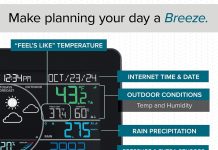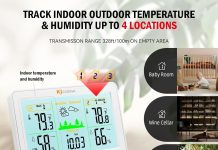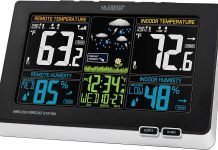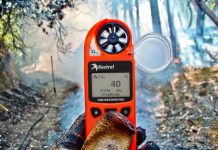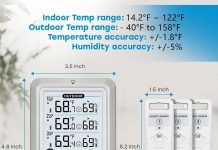Ladies and gentlemen, have you ever wondered about the little instrument that quietly sits on top of every weather station, recording valuable information about the atmosphere? Today, we will unravel the mystery and reveal the true purpose of the barometer. This humble yet powerful device measures the atmospheric pressure, offering us insights into the ever-changing weather patterns. So, grab your umbrella or keep those sunglasses handy, because we are about to embark on a fascinating journey into the world of barometers and weather prediction.
Review contents
Barometer Basics
Definition of a Barometer
A barometer is a scientific instrument used to measure atmospheric pressure. It consists of a sealed container with a vacuum above a column of liquid, usually mercury or aneroid capsules. As the atmospheric pressure changes, it affects the level of liquid in the container, allowing us to determine the current atmospheric pressure.
Purpose of a Barometer
The main purpose of a barometer is to measure changes in atmospheric pressure, which is vital for weather forecasting and understanding weather patterns. By monitoring changes in atmospheric pressure, meteorologists can analyze weather conditions and make predictions about future weather events. Barometers are also used in various other fields, such as aviation, pilot instruments, and weather research.
Types of Barometers
Mercury Barometers
Mercury barometers are one of the oldest types of barometers and have been used for centuries. They consist of a glass tube filled with mercury, which is inverted and placed in a mercury-filled container. As atmospheric pressure increases, it pushes the mercury up the tube, and as the pressure decreases, the mercury levels drop. The height of the mercury column is then used to calculate the atmospheric pressure.
Aneroid Barometers
Aneroid barometers are a more modern and compact type of barometer. They do not use mercury and instead rely on the movement of an aneroid capsule, which is a flexible metal chamber partially evacuated of air. When the atmospheric pressure changes, it causes the capsule to expand or contract, which is then translated into a dial or digital display, indicating the current pressure.
Digital Barometers
Digital barometers, as the name suggests, use digital technology to measure and display atmospheric pressure. They are often equipped with additional features like temperature and humidity sensors, making them more versatile. These barometers use electronic sensors and microprocessors to provide accurate and real-time pressure readings. The digital display allows for easy reading and interpretation of the data.
How a Barometer Works
Understanding Atmospheric Pressure
Atmospheric pressure refers to the force exerted by the weight of the air above a specific point on the Earth’s surface. It is caused by the motion and weight of air molecules. The pressure decreases as you go higher in the atmosphere, and it increases as you go lower. Changes in atmospheric pressure are directly related to weather patterns. High-pressure systems indicate stable and clear weather, while low-pressure systems are associated with unsettled conditions and the potential for storms.
Measurement Units of Pressure
Atmospheric pressure is commonly measured in units of pressure called millibars (mb) or inches of mercury (inHg). One millibar is equivalent to 0.02953 inches of mercury. These units represent the pressure exerted by the atmosphere at a particular location. By monitoring changes in atmospheric pressure, meteorologists can provide valuable information for weather forecasting and understanding weather patterns.
Collecting and Recording Data
Weather Station Setup
To collect accurate barometric data, a weather station setup is essential. A weather station typically includes a barometer, along with other instruments such as thermometers, hygrometers (for measuring humidity), and anemometers (for measuring wind speed). The barometer should be placed away from direct sunlight, heat sources, and any obstructions to ensure accurate readings.
Barometric Readings
Barometric readings refer to the measurement of atmospheric pressure using a barometer. These readings can be taken manually by observing the height of the mercury column or the movement of the aneroid capsule. For digital barometers, the readings are displayed electronically. To ensure accuracy, multiple readings should be taken over a period of time and then averaged to account for any fluctuations.
Data Interpretation
Interpreting barometric data is crucial in understanding weather patterns and making weather forecasts. Rising barometric pressure indicates clearing weather, improving conditions, and increasing stability. Falling pressure suggests the potential for inclement weather, storms, or atmospheric instability. Rapidly changing pressure can indicate the approach of weather fronts or other significant weather events. By examining trends and patterns over time, meteorologists can accurately interpret the data and provide valuable insights.
Relationship between Barometer and Weather
High Pressure Systems
High-pressure systems, indicated by rising barometric pressure, are commonly associated with stable and fair weather conditions. The descending air within a high-pressure system inhibits the formation of clouds and precipitation. Clear skies, light winds, and generally pleasant weather are often observed in areas under the influence of a high-pressure system.
Low Pressure Systems
Low-pressure systems, characterized by falling barometric pressure, are typically associated with unsettled weather conditions. The ascending air within a low-pressure system leads to the cooling and condensation of moisture, resulting in cloud formation and potentially heavy precipitation. Low-pressure systems often bring about storms, rain, or other adverse weather conditions.
Forecasting Weather
Barometric pressure is a fundamental tool in weather forecasting. By monitoring changes in atmospheric pressure, meteorologists can track the movement and intensity of weather systems, predict the likelihood of precipitation, and identify potential weather patterns. Changes in pressure, along with other weather parameters, such as temperature, humidity, and wind patterns, provide valuable information necessary for accurate weather forecasts.
Barometric Pressure and Altitude
Effect of Altitude on Barometric Pressure
The relationship between barometric pressure and altitude is crucial to understanding weather conditions at different elevations. As altitude increases, atmospheric pressure decreases due to the decreasing density of air molecules. Consequently, areas at higher altitudes will typically experience lower atmospheric pressure compared to lower-lying regions. This variability in pressure with altitude plays a significant role in the formation of weather systems, cloud formation, and other atmospheric phenomena.
Applications of Barometers
Weather Forecasting
Weather forecasting heavily relies on accurate barometric measurements. Barometers provide insights into atmospheric pressure trends, allowing meteorologists to predict changes in weather patterns. Monitoring barometric pressure is a fundamental component of predicting storms, assessing the likelihood of precipitation, and forecasting weather conditions over short and long-term periods.
Aviation and Pilot Instruments
Barometers are vital instruments in aviation and play a crucial role in flight safety. Barometric pressure readings are used to determine aircraft altitude, airspeed, and accurate altimeter settings. Pilots rely on barometric data to navigate through different atmospheric layers and ensure safe and efficient flight operations.
Weather Research and Monitoring
Barometers are widely used in weather research and monitoring to understand weather patterns, climate changes, and atmospheric behavior. By collecting and analyzing barometric data from various locations, scientists can gain insights into global weather phenomena, measure pressure gradients, and track atmospheric anomalies. This research provides valuable information for climate studies, meteorological predictions, and environmental monitoring.
Importance of Accurate Barometric Readings
Impact on Weather Forecasting
Accurate barometric readings are essential for reliable weather forecasting. Changes in atmospheric pressure can provide early indications of developing weather patterns, enabling meteorologists to issue timely warnings and predict severe weather events. Precise measurements and interpretations of barometric data significantly enhance the accuracy and effectiveness of weather forecasts.
Significance for Atmospheric Studies
Barometric readings are indispensable in atmospheric studies, helping scientists deepen their understanding of the Earth’s climate and atmospheric behavior. Accurate measurements of atmospheric pressure contribute to ongoing research on climate change, weather patterns, and the overall dynamics of the atmosphere. This knowledge is crucial for developing strategies to mitigate the impacts of climate change and improve our understanding of the planet’s complex atmospheric systems.
In conclusion, barometers play a vital role in understanding and predicting weather patterns. Their ability to measure atmospheric pressure allows meteorologists to analyze changes in weather conditions and provide accurate forecasts. With various types of barometers available, including mercury, aneroid, and digital, collecting and interpreting barometric data has become more accessible and efficient. Through weather station setups and accurate data recording, scientists and meteorologists can continue to deepen their understanding of the atmosphere and provide valuable insights for weather forecasting, aviation, climate research, and environmental monitoring. Accurate barometric readings are essential for the advancement of atmospheric studies and improving our ability to predict and respond to weather-related events.


